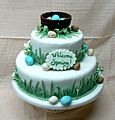Fondant icing facts for kids

Wedding cake covered and decorated with fondant
|
|
| Type | Confectionery |
|---|---|
| Place of origin | France |
| Main ingredients | Poured fondant: sugar, water, gelatin, glycerine Rolled fondant: sugar, water, gelatin or agar, food-grade glycerine |
Fondant is a special kind of icing used to decorate or sculpt cakes and pastries. It's made mostly from sugar, water, and other ingredients like gelatin or glycerol. Unlike most icings, fondant can be very firm, like a stiff clay, or a thick liquid.
The word "fondant" comes from a French word that means "melting." You might have heard of "fondue," which comes from the same root word!
Contents
Types of Fondant
Fondant comes in different forms, each used for different decorating jobs.
Rolled Fondant
Rolled fondant is a popular type of fondant. It's often called fondant icing or pettinice. This type is used to cover cakes, especially wedding cakes. It gives cakes a smooth, perfect finish.
Traditionally, wedding cakes were covered with marzipan. But more people are using rolled fondant now. This is because some people have nut allergies, and fondant doesn't need almond meal.
Rolled fondant usually contains gelatin (or agar for vegetarian recipes). It also has food-grade glycerine. These ingredients help keep the sugar soft and flexible. This makes the fondant feel like dough. You can roll it out, just like a pie crust, to cover a whole cake.
Many types of rolled fondant you buy in stores are made with sugar and hydrogenated oil. But there are also other kinds. Some use ingredients like sugar, cellulose gum, and water.
Marshmallow Fondant
Marshmallow fondant is a type of rolled fondant that many home bakers like to make. It's made by melting marshmallows and mixing them with water, powdered sugar, and vegetable shortening. It's a popular choice because the ingredients are easy to find.
Sculpting Fondant
Sculpting fondant is very similar to rolled fondant. However, it's much stiffer. This firm texture makes it perfect for shaping into figures or other decorations. Think of it like edible clay!
Sugar Paste or Gum Paste
Sugar paste or gum paste is like rolled fondant, but it gets very hard when it dries. Because it hardens completely, it's used for bigger cake decorations. This includes things like figures of people or large, detailed flowers. Sugar paste is usually made from egg whites, powdered sugar, and shortening. Sometimes, a special ingredient called Tylose is added. This makes the gum paste even more flexible for very detailed work.
Poured Fondant
Poured fondant is different from rolled fondant. It's a thick liquid that you can pour over cakes or candies. It creates a smooth, shiny coating.
Poured fondant is made by dissolving a lot of sucrose (sugar) in water. This creates a "supersaturated" solution. This means there's more sugar dissolved in the water than usual. When this sugary liquid cools down and is stirred quickly, tiny sugar crystals form. These tiny crystals make the fondant smooth and creamy. If it's not stirred correctly, you might get large, crunchy sugar crystals instead!
Gallery
-
The appliqué method uses one or more layers of cutout rolled fondant pieces to provide color and depth.
-
Red fondant on a Valentine's Day cake
See also
 In Spanish: Fondant para niños
In Spanish: Fondant para niños








